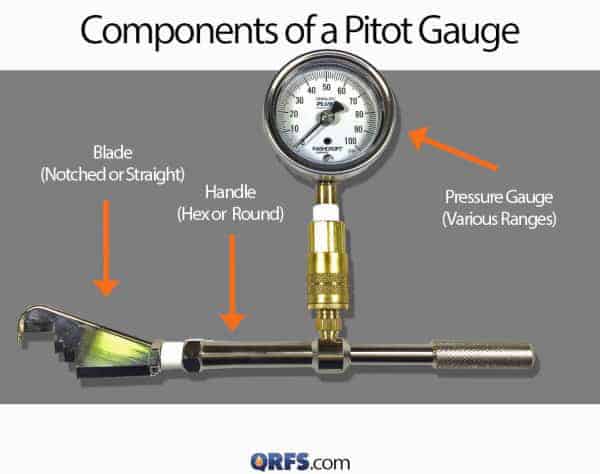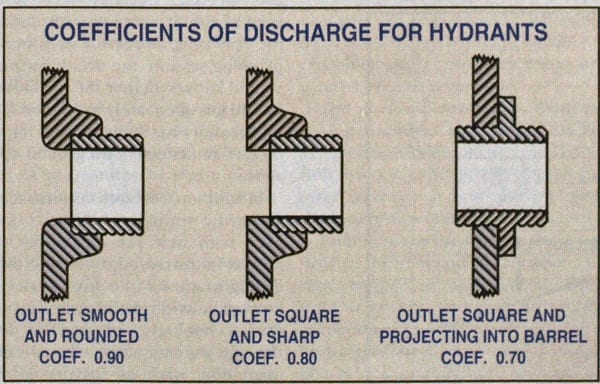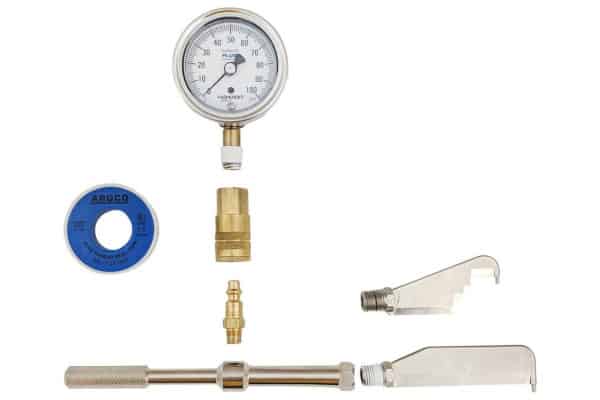Pitot gauges make it easy to get accurate GPM measurements for fire hydrant flow tests
Municipalities and other authorities require regular hydrant flow testing to ensure that fire hydrants can supply adequate water during an emergency. Pitot gauges make it simple to quickly measure the pressure of flowing water from fire hydrants, followed by converting those readings in pounds per square inch (PSI) to gallons per minute (GPM).
Read on as we describe what a pitot gauge is, why hydrant flow testing is necessary, who conducts these tests, and how to use a pitot gauge during a flow test. Just need to buy one or some accessories? We’ve got you covered.
How does a pitot gauge work?
The handheld pitot gauge remains the fastest and easiest method for measuring both straight-tip and hydrant-flow GPM. By calculating the GPM, inspectors can uncover reduced pressure and flow rates. Heavy pipe-wall deposits, compromised pipes, and closed valves are often discovered when analyzing data collected by hand-held pitot gauges.
A pitot gauge consists of three components: a blade, handle, and pressure gauge. Once placed within an open fire hydrant’s water discharge, a narrow tube inside the blade directs water toward the gauge to enable a pressure reading. The captured PSI readings can be used to calculate the disparities in pressure between two points along a distribution system.

The desirable unit of measure we seek from hydrant flow testing is a hydrant’s GPM. To convert from PSI to GPM, we refer to Bernoulli’s principle. Daniel Bernoulli, a Swiss mathematician, developed a formula to represent the relationship between velocity and pressure along a streamline. In practice, these conversions are often made using a theoretical discharge table, like the one we provide with our selection of pitot gauges.
Bernoulli’s equation, however, doesn’t account for friction produced when water flows through a pipe system. Represented mathematically, this friction is called the hydrant’s coefficient of discharge and it represents a pipe’s wall shape and roughness or abnormalities. The pipe’s coefficient is required to accurately convert PSI to GPM. The Moody diagram and Colebrook equation are both resources that can help in very specifically estimating a pipe’s coefficient. But in practice, the default coefficients of discharge in hydrant testing are usually 0.90, 0.80, or 0.70, based on the shape of the transition between the barrel of the hydrant and its outlet:

Once the coefficient is identified, you’re ready to convert to GPM.
Who performs fire hydrant flow tests with pitot gauges?
City officials and professional contractors perform hydrant flow tests with pitot gauges. The steps they follow typically reflect the National Fire Protection Association’s NFPA 291: Recommended Practice for Fire Flow Testing and Marking of Hydrants. It is recommended that an appropriate representation of a city’s distribution system is tested every five years (section 4.15.1).
Besides peace of mind for emergencies, the tests enable municipalities to color-code their fire hydrants according to their strength of output. This allows fire departments to assess their water resources quickly when arriving on the scene of an emergency.
How to use a pitot gauge in 10 steps
Below are 10 high-level steps for performing a hydrant flow test with a pitot gauge. It is by no means a comprehensive guide. Consider consulting your local fire department or inspector if you want detailed, local information.
- Determine the location of the test by selecting a group of hydrants in the same vicinity. Per NFPA 291, as many as eight hydrants may be required for systems with large water mains and a strong system.
- Mark the hydrant measuring pressure as the ‘residual’ hydrant. Both static pressure (when flow hydrants are closed) and residual pressure (when flow hydrants are open) are measured from this hydrant. The residual hydrant should be between the hydrant(s) to be flowed and the large mains that supply water to the area.
- Flush the residual hydrant to remove any sediment and attach a nozzle cap with a gauge to the hydrant’s outlet.
- Slowly release the main valve until air is vented. Take a static pressure reading.
- Measure the inside diameter of the outlet nozzle or hydrant outlet where flow occurs. A hydrant’s inside diameter is usually 4”.
- Field personnel should slowly open each fire hydrant, one at a time, to avoid pressure surges.
- After the residual pressure read from the outlet cap stabilizes, take readings at each hydrant using a pitot gauge. Residual pressure and pitot gauge readings must be taken simultaneously. For accurate pitot gauge readings, the pitot tube should be held downstream and in the center of the nozzle.
- Record both the residual and pitot gauge readings.
- Slowly close each fire hydrant.
- Use the PSI readings from the residual hydrant’s static and residual pressure, the coefficient determined by measuring the inside diameter of the hydrant’s outlet nozzle, and other factors to determine two sequential numbers using two sequential formulas: the discharge, aka the gallons flowing during the test (gpm), followed by the flow predicted at the desired residual pressure, aka the available fire flow. For a detailed explanation of applying the numbers to these formulas read the “math needed to assess the results section” in this blog.
Now that you know how to conduct a hydrant flow test with a pitot gauge, check out this short clip to see one in action:
How to choose a pitot gauge
If you’re in the market for a new pitot gauge, keep the following tips in mind:
- The pitot gauge will be held against powerful flows. Make sure the gauge is light but has a firm grip.
- Look for a rotating pitot gauge on a quick disconnect fitting for easier reading and faster draining of the system.
- For playpipe or hose nozzle readings, choose a kit with a notched blade in addition to the straight blade required for hydrant and pump testing.
For a compact, lightweight, and accurate pitot gauge, look no further than the QRFS’s selection of pitot gauge kits. We’ve got kits ranging from our Base Flow Test Kit, which includes an 8 in. (203 mm) hex handle, a 4 in. (101.6 mm) standard metal blade, a 2 1/2 in. (63.5 mm) liquid-filled gauge, a roll of Thread Seal Tape, and a portable foam-lined carrying case, to the 807 Flow Test Kit, which has two gauges, three hydrant test caps, a hydrant flow elbow, a stream-straightening fire hydrant flow nozzle, quick-disconnect double-ball-valve-bleeder, two blades, spare gaskets, and more.
View our selection of Pitot Gauge and Flow Test Kits plus our other flow testing equipment and accessories.
And for more information on hydrant testing, read our in-depth blog: “NFPA Guidance on Fire Hydrant Testing.”
Questions about this article or our pitot gauges? Call us at +1 (888) 361-6662 or email support@qrfs.com.
This blog was originally posted on May 20, 2016, by Jason Hugo and Cameron Sharp of Quick Response Fire Supply, and updated on Nov. 28, 2022. Like what you read? Check out other articles at blog.qrfs.com



Our company is engaged in Mechanical Construction here in Manila Philippines. I have a testing instrument requirements particularly Pitot Gauge Kit for measure Residual Pressure for Water. May I request to send the contact details of your local distributor here in Manila Philippines.
Have a nice one.
Sherwin, thank you for reaching out. All our products are sold online. We have a wide selection of testing equipment including pitot gauges. If you can’t find what you are looking for you can contact us at 888-361-6662 or support@qrfs.com.
I’m looking to update our fire hydrants records and I looking to do it right. Let’s say I want to test and record the results for fire hydrant A. Is the static and residual reading taken from hydrant A and the flow rate taken off a completely different hydrant? OR do I connect the pitot gauge to hydrant A and get the static and residual off a completely different hydrant? Remember hydrant A is the hydrant I want to update.
Don, thanks for your question. We will have our Support Team reach out to assist.
What is the recommend way to test gpm flow in a resident?
Billy, thanks for reaching out. For questions like this, we recommend submitting your question through QRFS Ask A Pro. Click the link to submit your question with some information about your building or system, and a fire protection professional will provide a detailed answer based on standards and codes. Our pros include AHJs, contractors, engineers, and code experts with 150+ years of combined experience!
Most important part of the flow test was left out: A long tarp to lay on ground to prevent you from washing out the lawn or roadway shoulder while you blast open the flow hydrant!
Thanks, James, good point!
Hi there, does the PSI Pressure reading on the Pitot Gauge Kit reflect the actual Flow Pressure as well? Appreciate your advice.
Eugene — If by “flow pressure” you mean GPM (the standard measure of flow), the PSI must be converted to GPM using a formula (or a calculator designed to do it). We’ve got a complete guide to doing that here!
We need pitot gsuge kindly send your distributor name in India
Please send us
V. Pandiyan
V — We do not have a distributor in India, but you can order pitot gauges online and we can ship to India. In future, if you need quick customer service, please email support@qrfs.com. Thank you!
Can the velocity pressure at hydrant #2 ever be higher than the static pressure of hydrant #1